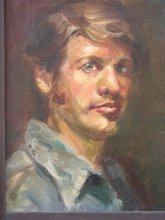

A long time ago when I was in teacher training for the Waldorf School, I created the grade school curriculum poster for an assignment to express the curriculum in any way we wanted. So I came up with the idea of making it like a game board. On my own, just after this, I did one for the high school curriculum. Now, at the expense of revealing a secret, the other students really did not like me very much. I used to do many of the assignments turning them into a song or poem which seemed to irritate the others, one of whom called me an "overachiever", not in a nice way, I thought. Secretly I gave this high school poster to one of the teachers, Ron Richardson and Magda Lissau, told him about the "overachiever" comment and asked if he would just have a look and not show it to the students. So, after all these years, I am showing it here --- although in an abbreviated manner. I get a little irritated when I see my poster showing up in places I never intended, so I've cropped my picture. What you can see is the "etheric heart" in the center guarded by St. Michael battling the dragon circling the outside of the heart. The Etheric Heart is a concept that I can't explain in 25 words or less, but some of you Waldorf people will understand. At the four corners are Celtic representations of the four elements: earth, air, fire and water, all surrounded by Celtic knotwork and color. I spent quite a while on this and I think I made my point to the directors of the teacher training. This was done in about 1993 and despite the training, or because of it, I let my artwork carry me through many aspects of the training. When you are trained to do what you do, don't suppress it. Anyone looking for the Waldorf Curriculum poster for the grade school can find what is left of them at the Madison (Wisconsin) Waldorf School. I gave them the last copies that I had. The High School poster never has been reproduced. So that's the story of that.












